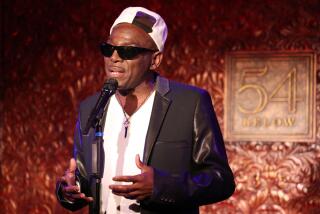DANCE REVIEW : TANDY BEAL’S VERSION OF ‘NUTCRACKER’
- Share via
“The Nutcracker” has always been a ballet about magical transformations of the familiar: Christmas party into nightmare-battle into dream-apotheosis, Christmas toy into heroic warrior into handsome prince.
With great purity of heart and remarkable theatrical savvy, Tandy Beal’s non-balletic version manages to renew and even enhance these (by now) ritual metamorphoses. Her basic ploy: heightening the sense of familiarity by a major shift in context.
Seen Wednesday in the Little Theatre of Cal State Fullerton, Beal’s 1982 production (originally staged in Santa Cruz) features settings by Norvid Jenkins Roos that resemble contemporary Christmas cards in both graphic style and flat, fold-out shape. No quasi-nostalgic evocations of a 19th-Century household remote from our experience but, instead, artful stylizations (and idealizations) of the here-and-now.
Similarly, Elaine Yokoyama Roos’ costumes refer to the world we know--with the menacing mice, for instance, dressed in metallic baseball jackets like a street gang and dancing rather like a rodent company of “West Side Story” (“When you’re a rat, you’re a rat all the way . . . . “).
Besides this dollop of Robbins-esque ballet-jazz, Beal incorporates nearly every movement form imaginable, for in this era of anything-can-be-dance, little Claras may well dream of being Mary Lou Retton rather than Natalia Makarova. Indeed, through affectionate pastiche Beal achieves a dazzling collage affirming the unprecedented variety of American dance and, along the way, manages to include deft tributes to specific creators.
Thus her revision of the “Mother Ginger” episode features two abnormally tall women--who seem to sport bare male legs under their long skirts just like the ladies in Pilobolus’ “Untitled.” (Beal sharpens the parallel by adding group gymnastics to the sequence, a reminder of Pilobolean origins.)
With its translucent veils and kaleidoscopic lighting, her own solo (to the music for what is usually the adagio of the Grand Pas de Deux) is obviously an homage to modern dance pioneer Loie Fuller. And one is tempted to see in the elastic cat’s cradles of Beal’s Snowflake Waltz an allusion to “Tensile Involvement,” the celebrated work by her mentor, Alwin Nikolais.
Beal also serves up tolerably authentic flamenco (the Spanish Dance), highly musical juggling (the Chinese Dance), suave exhibition ballroom (Waltz of the Flowers), flamboyant roller skating, whimsical post-modern structuralism and even showbiz pseudo-exoticism (an Arabian Dance that looks like a production number from a Hope-Crosby “Road” picture). Most of it suits Tchaikovsky’s score (on tape) better than you’d expect: Beal has always been a craftsperson of exceptional skill.
And, despite all its choreographic caprices, Beal’s “Nutcracker” is never an experience to be decoded; it remains resolutely free of stylistic pretension and retells the original story more faithfully than most ballet stagings currently do.
Certainly the first scene--with vignettes of separated friends, lovers and family members reunited on the way to the party--shows an understanding of the emotional underpinnings of “The Nutcracker” that the opulent Long Beach Ballet version has always lacked and the resourceful West Side Ballet version seems to have lost.
Though she is no traditionalist, Beal knows why “The Nutcracker” is a classic, and that knowledge gives her staging an unforced sweetness and deep credibility.
Because it is so unassuming, so much a freewheeling pleasure fair, the production can easily weather the kind of uneven, accident-prone, partly professional and partly student performance it received Wednesday. (The seven-performance engagement is a project of the Cal State Fullerton Theatre and Dance departments under the PAIR--Professional Artists in Residence--program.)
Of the principals, Ellen Sevy mimed and danced the role of Clara with extraordinary naturalness and Ron Taylor made a supersmooth partner as her prince. Beal was a gracious Sugar Plum Fairy and her father, actor John Beal, served as a wryly eccentric Drosselmeyer.
Among the other soloists, the skating team of Czarina and Belson deserves special mention for preserving a fearless, hell-on-wheels attack despite the clear and present danger of rolling off a very narrow stage into the audience.
More to Read
The biggest entertainment stories
Get our big stories about Hollywood, film, television, music, arts, culture and more right in your inbox as soon as they publish.
You may occasionally receive promotional content from the Los Angeles Times.










